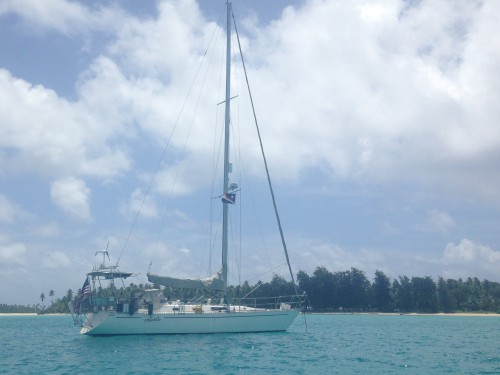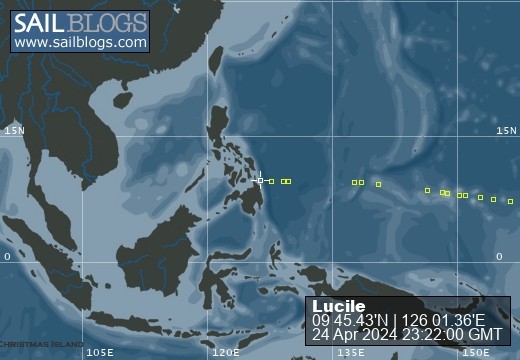Kiribati
When I last wrote, we were ten days and 750 miles or so into our passage from Pago Pago to Tarawa.
After 25 days at sea, we made it to Port Betio, Tarawa, Kiribati.
Those last 15 days were �... interesting. I was reviewing our track the other day, and it still amazes me how much time we spent adrift, with no wind at all. None, zip, nada, zero. And a two-knot current to the east, so we would get set east (our destination was west), about two miles for every hour we drifted. And we drifted for days at a time. We had plenty of food and water, so we can sleep, read, watch TV and movies (from our iTunes library), and otherwise chill.
Not too chill, though, being as close to the equator as we are. Some of those days with no wind you�'d break out in a sweat just sitting still, wake up in the morning and the pillows and sheet are damp from sweat.
The worst part was, we didn�'t stock quite enough rum. Oh, well. That didn�'t detract from the multiple encounters of a cetacean kind. Falsies got prominent mention in the last blog. but our drift zone produced many encounters of dolphins, and our final approach to Tarawa, 20 miles northeast of the Maina atoll, we saw a whale. Species ID is a bit sketchy. Well, the spinners (three or four separate occasions, over a couple or three days) were relatively easy to identify, based on their spinning behavior. The other dolphin species was not so easy to identify. They had falcate fins, and looked very much like pantropical spotted dolphins, except no spots. Our Marine Mammals book says spotted dolphins come with a wide range of �'spottedness�', including none, so I tentatively put them down as spotted. Behaviorally, they did high jumps, including that landing on their shoulder one, so consistent with what I�'ve seen with spotteds off Lana�'i.
The whale is even harder to identify, as all we saw of it was a portion of the back and it�'s dorsal fin as it blew. It stayed near the surface for quite a while, and meandered back and forth Lucile�'s path for the duration of our approach and departure. We saw the blow from the side only, so not a lot of information from the shape of the blow. The dorsal fin was definitely falcate. The closest we can guess, with aid of our Marine Mammals book, is a Dwarf Bryde�'s Whale.
Our landfall was prodigiously fine, if I say so myself. After days of calm and near calm, the weather turned ugly for our final approach. Lots of wind, and right in our face. We motor-sailed into increasing wind and seas, found the channel, and came of the wind to sail into the anchorage. Holding was good, sandy bottom, and the anchorage shallow (25 feet) right outside the �"port�", so got a good set first time we dropped the hook. The wind was blowing so hard, we didn�'t have to back down on the engine to set it. The wind was blowing so hard, it was pulling the chain out of the locker, even with the windlass �"off�". Put the snubber on (three-stand nylon, ?�", spliced to a stainless chain hook), let out 30 feet, and made all fast to a cleat. All good. The wind has been so consistent here that we�'ve hardly moved from our set position. Most places we�'ve anchored, our track makes a circle around the anchor, spending time at various headings depending on the wind. Not so here. One direction, the wind, and mostly one speed: 15 knots. The anchorage is occasionally flat, but we pitch a lot. Quite a lot. There have been days that one or the other of us feels a bit seasick.
Days �... almost a week. If you read cruising notes and guides, you will not find a lot of praise for Betio. There is good reason for this. This place is a real pit. Our primary objectives here were to rest and re-fuel. We�'re doing okay on the rest (pitching ceaselessly on a windy anchorage is not the best way to find your rest). Fueling is also challenging. There is plenty of fuel available, but no �'fuel dock�'. If you want at least 100 gallons fo diesel, you can have barrels delivered to the commercial dock, but you have to make your own provisions for moving the diesel out of the barrels and in to the fuel tanks. Our approach is to ferry jerry cans back and forth to Lucile at anchor. And there�'s a service station very handily located right by the port facilities. But they are closed, pending replacement of fuel pumps. On Saturday, the two new pumps were sitting next to the two old pumps, and work was plainly in progress to complete the project over the weekend. Didn�'t check Sunday, as most things are generally closed on Sundays. Monday, the gasoline pump was installed, and the diesel pump was sitting by it�'s pedestal, with workers busy fishing cables through the conduit in the freshly-poured ditch from the garage building to the pump island. Today, the gasoline pump still stood in place, no sign of a diesel pump, no sign of work or workers, and nobody around who spoke enough English to answer my question: when will diesel be available.
Tomorrow I guess we will look for another service station. We have been told there are three, although in our initial exploratory foray ashore, we only found the one. I am fifty gallons short of getting the flock out of here. Wish me luck.
Next stop, Majuro, Marshall Islands.
Aloha
After 25 days at sea, we made it to Port Betio, Tarawa, Kiribati.
Those last 15 days were �... interesting. I was reviewing our track the other day, and it still amazes me how much time we spent adrift, with no wind at all. None, zip, nada, zero. And a two-knot current to the east, so we would get set east (our destination was west), about two miles for every hour we drifted. And we drifted for days at a time. We had plenty of food and water, so we can sleep, read, watch TV and movies (from our iTunes library), and otherwise chill.
Not too chill, though, being as close to the equator as we are. Some of those days with no wind you�'d break out in a sweat just sitting still, wake up in the morning and the pillows and sheet are damp from sweat.
The worst part was, we didn�'t stock quite enough rum. Oh, well. That didn�'t detract from the multiple encounters of a cetacean kind. Falsies got prominent mention in the last blog. but our drift zone produced many encounters of dolphins, and our final approach to Tarawa, 20 miles northeast of the Maina atoll, we saw a whale. Species ID is a bit sketchy. Well, the spinners (three or four separate occasions, over a couple or three days) were relatively easy to identify, based on their spinning behavior. The other dolphin species was not so easy to identify. They had falcate fins, and looked very much like pantropical spotted dolphins, except no spots. Our Marine Mammals book says spotted dolphins come with a wide range of �'spottedness�', including none, so I tentatively put them down as spotted. Behaviorally, they did high jumps, including that landing on their shoulder one, so consistent with what I�'ve seen with spotteds off Lana�'i.
The whale is even harder to identify, as all we saw of it was a portion of the back and it�'s dorsal fin as it blew. It stayed near the surface for quite a while, and meandered back and forth Lucile�'s path for the duration of our approach and departure. We saw the blow from the side only, so not a lot of information from the shape of the blow. The dorsal fin was definitely falcate. The closest we can guess, with aid of our Marine Mammals book, is a Dwarf Bryde�'s Whale.
Our landfall was prodigiously fine, if I say so myself. After days of calm and near calm, the weather turned ugly for our final approach. Lots of wind, and right in our face. We motor-sailed into increasing wind and seas, found the channel, and came of the wind to sail into the anchorage. Holding was good, sandy bottom, and the anchorage shallow (25 feet) right outside the �"port�", so got a good set first time we dropped the hook. The wind was blowing so hard, we didn�'t have to back down on the engine to set it. The wind was blowing so hard, it was pulling the chain out of the locker, even with the windlass �"off�". Put the snubber on (three-stand nylon, ?�", spliced to a stainless chain hook), let out 30 feet, and made all fast to a cleat. All good. The wind has been so consistent here that we�'ve hardly moved from our set position. Most places we�'ve anchored, our track makes a circle around the anchor, spending time at various headings depending on the wind. Not so here. One direction, the wind, and mostly one speed: 15 knots. The anchorage is occasionally flat, but we pitch a lot. Quite a lot. There have been days that one or the other of us feels a bit seasick.
Days �... almost a week. If you read cruising notes and guides, you will not find a lot of praise for Betio. There is good reason for this. This place is a real pit. Our primary objectives here were to rest and re-fuel. We�'re doing okay on the rest (pitching ceaselessly on a windy anchorage is not the best way to find your rest). Fueling is also challenging. There is plenty of fuel available, but no �'fuel dock�'. If you want at least 100 gallons fo diesel, you can have barrels delivered to the commercial dock, but you have to make your own provisions for moving the diesel out of the barrels and in to the fuel tanks. Our approach is to ferry jerry cans back and forth to Lucile at anchor. And there�'s a service station very handily located right by the port facilities. But they are closed, pending replacement of fuel pumps. On Saturday, the two new pumps were sitting next to the two old pumps, and work was plainly in progress to complete the project over the weekend. Didn�'t check Sunday, as most things are generally closed on Sundays. Monday, the gasoline pump was installed, and the diesel pump was sitting by it�'s pedestal, with workers busy fishing cables through the conduit in the freshly-poured ditch from the garage building to the pump island. Today, the gasoline pump still stood in place, no sign of a diesel pump, no sign of work or workers, and nobody around who spoke enough English to answer my question: when will diesel be available.
Tomorrow I guess we will look for another service station. We have been told there are three, although in our initial exploratory foray ashore, we only found the one. I am fifty gallons short of getting the flock out of here. Wish me luck.
Next stop, Majuro, Marshall Islands.
Aloha



Comments